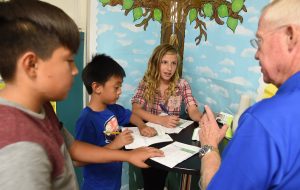
Hudson Elementary is one of two SRP Schools of Energy in the Tempe Elementary district (Ward Traditional Academy is the other). This means the schools have partnered with SRP in order to educate their teachers
and their students about the importance of energy conservation, both at school and at home.
“It’s never too early to learn about energy conservation,” said Hudson Principal Dr. Jeff Shores. That’s one of the reasons we at Hudson Elementary wanted to partner with SRP and become an SRP School of Energy.”
Amie Poletski and Katie Anderson are both fifth-grade teachers at Hudson; they are also the energy
ambassadors for the school and for the district.
They spent two Saturdays attending SRP Powering Our Future trainings, learning how to implement the energy
conservation program in their own classrooms and schoolwide.
On the day SRP came to offer an energy conservation lesson, Poletski’s and Anderson’s classes made predictions
to see what appliances and electronics use the most energy—an alarm clock, blow-dryer, desk fan, incandescent light bulb, CFL light bulb, LED light bulb, tablet, laptop, cell phone, or electric pencil sharpener.
Students then divided into groups and rotated to different stations throughout the classroom to test each appliance using SRP’s Tricklestar energy monitor, which reads the appliance’s real-time cost per hour, day, month or
year on an LCD display.
Each student noted the readings in a booklet. After rotating through all the stations and conducting tests using the Tricklestar device, they discovered that their prediction of the blow-dryer being one of the lowest users of energy was
the exact opposite, actually using the most.
They learned that traditional incandescent light bulbs use more energy than LEDs and CFLs (compact fluorescent
lamps). They also found that their electric pencil sharpener costs about $100 per year to use.
Multiply that by the number of classrooms that use them, and going back to the hand-powered or little plastic pencil sharpeners would save the school a significant amount of money.
Fifth-grader Alyssa O’Dell got a lot out of the lesson. “I feel like it’s giving us a chance to learn new things that we don’t usually get to learn,” she said. “And it’s about real world things we can use. It’s very interesting.”
When asked what she learned from this, classmate Nyomi Zuniga added, “We learned that we shouldn’t
be using a blow-dryer so much.”
This project really had the students thinking about how much energy the devices around them, both at school and at home, use. In a class discussion, one boy raised his hand and asked how much energy the Tricklestar energy monitor
itself uses. So they quickly tested it and discovered that it doesn’t even draw enough power to register on
the monitor.
“Some appliances use energy even when you have them turned off,” explained Poletski. “They’re called
energy ‘vampires’.”
The TrickleStar energy monitor can help you find these vampires, so you can unplug these devices when
you aren’t using them.
Once you know how much energy your appliances and electronics are using, you can take action to reduce
your energy usage and lower your monthly energy bills.
At the end of the lesson, the students all received silicone wristbands that say: “Be a Hero. Power Down to
Zero.”
The wristbands are a simple reminder for them about the importance of conserving energy any way they can.
Two of the biggest energy wasters at schools are laptop carts and laminators. Unplugging
things when they aren’t being used really helps. It’s really just a habit, like turning off the lights when you leave a room.
Poletski said she hopes the energy saving measures they implement this year will result in much lower
energy bills for the school. They are monitoring and will be able to tell just how much they saved at the end
of the school year.
District Energy Education Coordinator Steven Church says SRP will be regularly supplying reports to the school on its electricity usage, similar to what he tracks districtwide. The program is much more focused on the students and getting them involved in conserving energy at their school, he notes.
“It’s like having me at the school every day, all day, looking for ways to save, which I obviously can’t do for every school and district site,” said Church. “It is a great program and I hope we can expand it to more schools in the coming years.”
Poletski and Anderson also hope to start an afterschool energy conservation club so their
students can become energy ambassadors for the school as well.
Amie Poletski is excited about being an energy ambassador for her school and for the district. “Energy
means money,” she said simply.
“If we can save energy, we save money, the polar bears, and eventually the planet. If we can show it at
the school level, they can also take what they have learned home and use it there as well.”
Hudson Elementary has a TrickleStar energy monitor available in their library for class or student
checkout, but Valley residents can also check out a TrickleStar energy monitor at the Tempe Public Library or other
nearby public library for free, to find out how much energy their household appliances and electronics use.
(The devices are also available for purchase through Amazon.)
Find locations to borrow a TrickleStar energy monitor: http://www.savewithsrp.com/advice/appliance/
EnergyAnalyzerLocations.
[the_ad_placement id="below-menus"]
Energy tutors help schoolkids learn a real-life lesson
[the_ad_placement id="bottom-post"]

